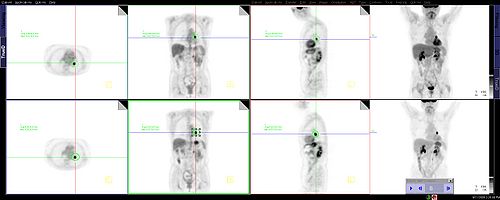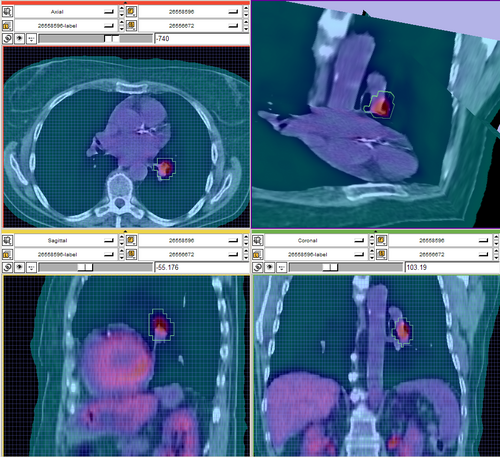Slicer3:UIDesign:WorkingProblems:BCAnalysis:PET
From Slicer Wiki
Home < Slicer3:UIDesign:WorkingProblems:BCAnalysis:PET
Back to Project Overview
Contents
SUV Analysis for Breast Cancer
Goal
Goal is to accommodate basic RECIST assessment for breast cancer (Response Evaluation Criteria In Solid Tumors). (RECIST is a set of published rules that define when cancer patients improve ("respond"), stay the same ("stable") or worsen ("progression") during treatments).
- Determine features that currently exist in Slicer
- Develop features that don't
- Provide a framework that knits features together in a comfortable workflow.
PET SUV Analysis Workflow
- Segment the tumor by hand (ROI or VOI, can be simple circle or ellipsoid)
- Compute SUV of baseline
- extract parameters from dicom header including
- concentration
- injected activity
- patient weight
- SUV = ( concentration (microcuries/cc) / injected activity (microcuries) ) - (patient weight (g))
- use maximum value
- extract parameters from dicom header including
- Compute SUV of followup
- extract parameters from dicom header including
- concentration
- injected activity
- patient weight
- SUV = ( concentration (microcuries/cc) / injected activity (microcuries) ) - (patient weight (g))
- use maximum value
- extract parameters from dicom header including
- Normalize ROI by SUVmax
- Resport parameters of interest
- SUVmax_baseline,
- SUVmax_followup,
- % change
- For multiple tumors, report
- sum of SUV_baselines
- sum of SUV_followup
- percent change
Approach
Started a PET_SUV module in Slicer that
- lets you choose a pre-treatment pet volume
- lets you choose a post-treatment CT volume (if present)
- lets you choose pre & post-treatment label maps.
- displays them in FG/BG with correct LUT
- pulls parameters of interest for SUV calculation from DICOM header
- has entry widget for parameters missing from header
- computes measures of interest as described above.
- no special viewer for now.
- ...
Resources
case study MS PPT Slides shows tumor
MS Word document with DICOM tags for SUV
Slicer Display at present
TODO & Questions for Ron/Jeffrey
- Same case as Draft display -- same case as ppt slides?
- Check DICOM tags; not all are found for computing suv?
- Radiopharmaceutical Start Time (0018,1072)
- Decay Correction (0054,1102)
- Decay Factor (0054,1321)
- Frame Reference Time (0054,1300)
- Radionuclide Half Life (0018,1075)
- Series Time (0008,0032)
- Patient Weight (0010,1030)
- Radionuclide Total Dose (0018,1074)
- Correction (7053,1009) (counts to Bq/cc)
- Philips SUV Factor (7053,1000) (custom)
- Normalize ROI by SUVmax?
- Get good volume render for slides.
- Help from Nicole on min/max & LUT scaling -- access via volumes module (not exposed in API)?
- PropagateVolumeSelection after touching node selectors auto-fits data to win -- so annoying! fix.
Approach & STATUS
For each label value/color: create a binary volume that includes only that label use that binary as a stencil on the PET volume if the number of voxels in the stenciled image > 0 get the maximum Cpet get the mean Cpet (no max_mean yet) no unit conversion yet (assumes MBq/ml
- will work for single or multiple tumors under one label
- can be made to work for different labels, if want to assess tumors separately.
- need to:
- wire up display panel inside module
- test and verify SUV calculation
- add unit correction for all vendors
- detect vendor and use special calculations for Philips
- improve overall usability



